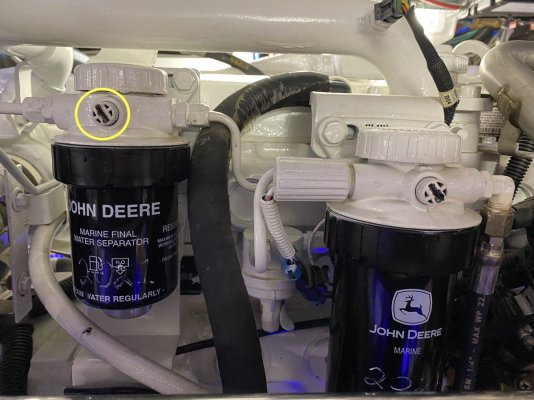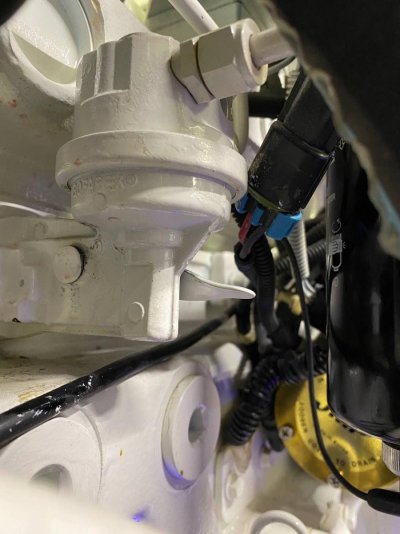scurvydog_pnw
Veteran Member
- Joined
- Dec 27, 2020
- Messages
- 63
Well another week another project to look at.
So this is our second fuel filter change on our John Deere 4045 engines on our boat. Everything was pretty easy. Changed the secondary fuel filters on our Racors, changed the water filter and primary filter on our JD. The issue came when trying to prime the primary fuel pump when done.
The manual fuel lift pump as seen in the photos just would not bleed the air out of the system. I loosed the bolt circled in the pic on the water filter and cranked that puppy over a hundred times with the no luck. Could not even get bubbles to come out. We had to resort to cracking the nut on the primary fuel pump and cranking the engine over a dozen times or more to get the air out.
Now I have done this many times on our old Cats. with practically the same type of pump with no problem.
I remember having issues the last time not being able to prime the engines using the manual pump level as well. Once primed engines run without issue until next filter change.
We have multiple fuel tanks on the boat so the fuel level relative to the pump could be +/- 18". Fuel does go through a manifold system to a dedicated dual racor system for each engine as pictured.
Thoughts on why these pumps are not seeming to fill the primary fuel filter on the engine and then prime?
So this is our second fuel filter change on our John Deere 4045 engines on our boat. Everything was pretty easy. Changed the secondary fuel filters on our Racors, changed the water filter and primary filter on our JD. The issue came when trying to prime the primary fuel pump when done.
The manual fuel lift pump as seen in the photos just would not bleed the air out of the system. I loosed the bolt circled in the pic on the water filter and cranked that puppy over a hundred times with the no luck. Could not even get bubbles to come out. We had to resort to cracking the nut on the primary fuel pump and cranking the engine over a dozen times or more to get the air out.
Now I have done this many times on our old Cats. with practically the same type of pump with no problem.
I remember having issues the last time not being able to prime the engines using the manual pump level as well. Once primed engines run without issue until next filter change.
We have multiple fuel tanks on the boat so the fuel level relative to the pump could be +/- 18". Fuel does go through a manifold system to a dedicated dual racor system for each engine as pictured.
Thoughts on why these pumps are not seeming to fill the primary fuel filter on the engine and then prime?




